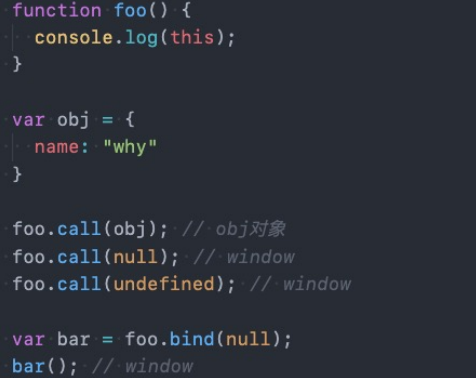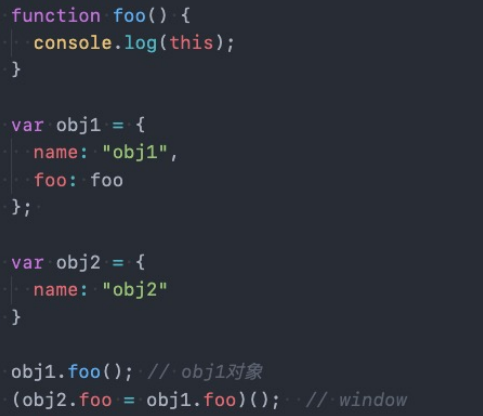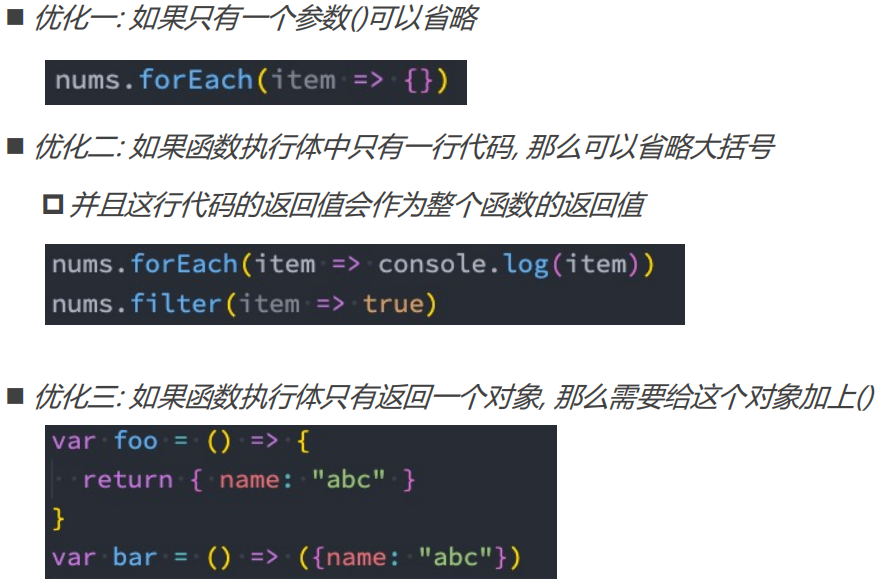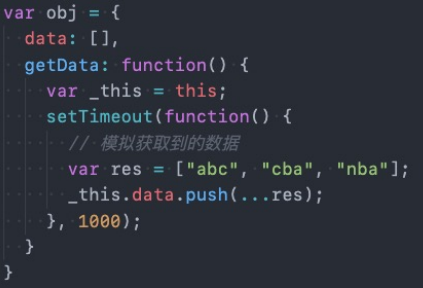In depth JavaScript learning notes: this point of function
- Reference: Teacher Wang Hongyuan's in-depth JavaScript course
Why do you need this?
- In common programming languages, almost all have this keyword (self is used in Objective-C), but this in JavaScript is different from this in common object-oriented languages:
- In common object-oriented programming languages, such as Java, C + +, Swift, Dart and so on, this usually only appears in the methods of classes.
- That is, you need to have a class, class method (especially instance method), this represents the current calling object.
- But this in JavaScript is more flexible, no matter where it appears or what it represents.
- Let's take a look at the difference between writing an obj object with this and without this

What does this point to?
- What does this point to under the global action?
// In most cases, this appears in the function
// Under global scope
// Browser: window(globalObject)
// Node environment: {}
console.log(this)
// console.log(window)- However, this is rarely used directly under the global action in development, and it is usually used in functions.
- When all functions are called, an execution context will be created:
- In this context, the call stack and AO object of the function are recorded;
- this is also one of the records;
What does this point to?
- Example:
// What this points to has nothing to do with the position of the function
// It has something to do with the way the function is called
function foo() {
console.log(this)
}
// 1. Call this function directly
foo()
// 2. Create an object in which the function points to foo
var obj = {
name: 'why',
foo: foo
}
obj.foo()
// 3.apply call
foo.apply("abc")

- Let's start with a confusing question:
- Defining a function, we call it in three different ways, and it produces three different results
- What enlightenment can this case give us?
- 1. When the function is called, JavaScript will bind a value to this by default;
- 2. The binding of this has nothing to do with the defined location (the location of writing);
- 3. The binding of this is related to the calling method and the calling location;
- 4.this is bound at runtime;
- So what kind of binding rules is this?
- Binding 1: default binding;
- Binding 2: implicit binding;
- Binding 3: display binding;
- Binding: new
Rule 1: default binding
- When do I use the default binding? Independent function call.
- Independent function call can be understood as that the function is not bound to an object for call;
- Let's take a look at several cases. For the common default binding, the following this is all window
// Default binding: independent function call
// 1. Case 1:
function foo() {
console.log(this)
}
foo()
// 2. Case 2:
function foo1() {
console.log(this)
}
function foo2() {
console.log(this)
foo1()
}
function foo3() {
console.log(this)
foo2()
}
foo3()
// 3. Case 3:
var obj = {
name: "why",
foo: function() {
console.log(this)
}
}
var bar = obj.foo
bar() // window
// 4. Case 4:
function foo() {
console.log(this)
}
var obj = {
name: "why",
foo: foo
}
var bar = obj.foo
bar() // window
// 5. Case 5:
function foo() {
function bar() {
console.log(this)
}
return bar
}Rule 2: implicit binding
- Another common calling method is to call through an object:
- That is, in its calling position, it is a function call initiated by an object.
- Let's take a look at the common default bindings through several cases
- Implicit binding: object fn()
- The object object will be bound to this in the fn function by the js engine
function foo() {
console.log(this)
}
// Independent function call
// foo()
// 1. Case 1:
var obj = {
name: "why",
foo: foo
}
obj.foo() // obj object
// 2. Case 2:
var obj = {
name: "why",
eating: function() {
console.log(this.name + "I'm eating")
},
running: function() {
console.log(obj.name + "Running")
}
}
obj.eating()
obj.running()
// 3. Case 3:
var obj1 = {
name: "obj1",
foo: function() {
console.log(this)
}
}
var obj2 = {
name: "obj2",
bar: obj1.foo
}
obj2.bar()
Rule 3: display binding
- Implicit binding has one prerequisite:
- There must be a reference to the function (such as an attribute) inside the called object;
- If there is no such reference, an error that the function cannot be found will be reported when calling;
- It is through this reference that this is indirectly bound to this object;
- What should we do if we don't want to include a reference to this function inside the object and want to make a forced call on this object?
- All JavaScript functions can use call and apply methods (this is related to Prototype).
- The difference between them will not be expanded here;
- In fact, it is very simple. The first parameter is the same. For the following parameters, apply is the array and call is the parameter list;
- The first parameter of these two functions requires an object. What is the function of this object? It's for this.
- When this function is called, this will be bound to the incoming object.
- All JavaScript functions can use call and apply methods (this is related to Prototype).
- Because of the above process, we explicitly bind the object pointed to by this, so it is called display binding
- Example:
function foo() {
console.log("The function was called", this)
}
//1. The difference between foo direct call and call/apply call lies in the difference of this binding
foo The direct call points to the global object(window)
foo()
var obj = {
name: "obj"
}
//call/apply is a binding object that can specify this
foo.call(obj)
foo.apply(obj)
foo.apply("aaaa")- Output:

- Example:
// 2. What's the difference between call and apply?
function sum(num1, num2, num3) {
console.log(num1 + num2 + num3, this)
}
sum.call("call", 20, 30, 40)
sum.apply("apply", [20, 30, 40])
//call and apply can explicitly bind this when executing functions. This binding rule is called display binding- Output:

- What can we do if we want a function to always be bound to an object?
function foo() {
console.log(this)
}
// foo.call("aaa")
// foo.call("aaa")
// foo.call("aaa")
// foo.call("aaa")
// Default binding and display binding conflict: priority (display binding)
var newFoo = foo.bind("aaa")
newFoo()
newFoo()
newFoo()new binding
- Functions in JavaScript can be used as constructors of a class, that is, using the new keyword.
- If you use the new keyword to call a function, the following operations will be performed:
- 1. Create a new object;
- 2. The new object will be prototype d;
- 3. The new object will be bound to this of the function call (this binding is completed in this step);
- 4. If the function does not return other objects, the expression will return this new object;
- Example:
// When we call a function (constructor) through a new keyword, this is the object created when calling the constructor
// this = created object
// This binding process is called new binding
function Person(name, age) {
this.name = name
this.age = age
}
var p1 = new Person("why", 18)
console.log(p1.name, p1.age)
var p2 = new Person("kobe", 30)
console.log(p2.name, p2.age)Rule Priority
- 1. The default rule has the lowest priority
- There is no doubt that the default rule has the lowest priority, because when there are other rules, this will be bound by other rules
- 2. The priority of display binding is higher than that of implicit binding
var obj = {
name: "obj",
foo: function() {
console.log(this)
}
}
obj.foo()
// 1. The explicit binding of call / apply is higher than the implicit binding
obj.foo.apply('abc')
obj.foo.call('abc')
// 2.bind takes precedence over implicit binding
function foo() {
console.log(this)
}
var obj = {
name: "obj",
foo: foo.bind("aaa")
}
obj.foo()
- 3.new binding takes precedence over implicit binding
var obj = {
name: "obj",
foo: function() {
console.log(this)
}
}
// new takes precedence over implicit binding
var f = new obj.foo() // foo {}- 4. The binding priority of new is higher than that of bind
- new binding, call and apply are not allowed to be used at the same time, so there is no higher priority
- New binding can be used together with bind, and new binding has higher priority
// new takes precedence over bind
function foo() {
console.log(this)
}
var bar = foo.bind("aaa")
var obj = new bar() // foo {}- new binding > apply / call / bind > implicit binding (obj. Foo()) > default binding (independent function call)
Outside this rule – ignore display bindings
- If we pass in null or undefined in the display binding, the display binding will be ignored and the default rule will be used:

Outside this rule - indirect function reference
- In another case, create an indirect reference to a function, which uses the default binding rules.
- The result of assignment (obj2.foo = obj1.foo) is foo function;
- If foo function is called directly, it is the default binding;

Arrow functionarrow function
- Arrow function is a method of writing function added after ES6, and it is more concise than function expression:
- The arrow function will not bind this and arguments attributes;
- The arrow function cannot be used as a constructor (it cannot be used with new, and an error will be thrown);
- How to write arrow function?
- (): parameters of function
- {}: executor of function

Programming optimization of arrow function

- Example:
// 1. Write arrow function
// 1> (): parameter
// 2> = >: arrow
// 3> {}: executor of function
var foo = (num1, num2, num3) => {
console.log(num1, num2, num3)
var result = num1 + num2 + num3
console.log(result)
}
function bar(num1, num2, num3) {
}
// When using higher-order functions, you can also pass in arrow functions
var nums = [10, 20, 45, 78]
nums.forEach((item, index, arr) => {})
// There are some common abbreviations for arrow functions:
// Abbreviation 1: if there is only one parameter, () can be omitted
nums.forEach(item => {
console.log(item)
})
// Abbreviation 2: if the function executor has only one line of code, {} can also be omitted
// Emphasis: and it will take the execution result of this line of code as the return value by default
nums.forEach(item => console.log(item))
var newNums = nums.filter(item => item % 2 === 0)
console.log(newNums)
// filter/map/reduce
var result = nums.filter(item => item % 2 === 0)
.map(item => item * 100)
.reduce((preValue, item) => preValue + item)
console.log(result)
// Abbreviation 3: if an arrow function has only one line of code and returns an object, how to write the abbreviation at this time
// var bar = () => {
// return { name: "why", age: 18 }
// }
var bar = () => ({ name: "why", age: 18 })
Outside this rule – ES6 arrow function
- The arrow function does not use the four standard rules of this (that is, it does not bind this), but determines this according to the outer scope.
var name = "why"
var foo = () => {
console.log(this)
}
foo()
var obj = {foo: foo}
obj.foo()
foo.call("abc")- Output:

- Take a look at a case that simulates a network request:
- Here, I use setTimeout to simulate the network request. How can I store the requested data in the data?
- We need to get the obj object and set data;
- However, the directly obtained this is window (setTimeout is called directly and bound by default). We need to define VaR in the outer layer_ this = this
- Used in the callback function of setTimeout_ this represents the obj object

- Use the arrow function:
var obj = {
data: [],
getData: function() {
// Send the network request and put the result in the data attribute above
// Solution before arrow function
// var _this = this
// setTimeout(function() {
// var result = ["abc", "cba", "nba"]
// _this.data = result
// }, 2000);
// After arrow function
setTimeout(() => {
var result = ["abc", "cba", "nba"]
this.data = result
}, 2000);
}
}
obj.getData()Exercises
- Exercise 1:
var name = "window";
var person = {
name: "person",
sayName: function () {
console.log(this.name);
}
};
function sayName() {
var sss = person.sayName;
sss(); // window: independent function call
person.sayName(); // person: implicit call
(person.sayName)(); // person: implicit call
(b = person.sayName)(); // window: assignment expression (independent function call)
}
sayName();- Exercise 2:
var name = 'window'
var person1 = {
name: 'person1',
foo1: function () {
console.log(this.name)
},
foo2: () => console.log(this.name),
foo3: function () {
return function () {
console.log(this.name)
}
},
foo4: function () {
return () => {
console.log(this.name)
}
}
}
var person2 = { name: 'person2' }
person1.foo1(); // Person1 (implicit binding)
person1.foo1.call(person2); // Person2 (display binding priority is higher than implicit binding)
person1.foo2(); // Window (no scope is bound, and the upper scope is global)
person1.foo2.call(person2); // window
person1.foo3()(); // Window (independent function call)
person1.foo3.call(person2)(); // Window (independent function call)
person1.foo3().call(person2); // Person2 (the final call returns the function expression, using the display binding)
person1.foo4()(); // Person1 (the arrow function is not bound to this, and the upper scope this is person1)
person1.foo4.call(person2)(); // Person2 (a person2 is bound to the displayed upper scope)
person1.foo4().call(person2); // Person1 (the upper layer finds person1)- Exercise 3:
var name = 'window'
function Person (name) {
this.name = name
this.foo1 = function () {
console.log(this.name)
},
this.foo2 = () => console.log(this.name),
this.foo3 = function () {
return function () {
console.log(this.name)
}
},
this.foo4 = function () {
return () => {
console.log(this.name)
}
}
}
var person1 = new Person('person1')
var person2 = new Person('person2')
person1.foo1() // person1
person1.foo1.call(person2) // Person2 (display higher than implicit binding)
person1.foo2() // Person1 (this in the upper scope is person1)
person1.foo2.call(person2) // Person1 (this in the upper scope is person1)
person1.foo3()() // Window (independent function call)
person1.foo3.call(person2)() // window
person1.foo3().call(person2) // person2
person1.foo4()() // person1
person1.foo4.call(person2)() // person2
person1.foo4().call(person2) // person1
var obj = {
name: "obj",
foo: function() {
}
} - Exercise 4:
var name = 'window'
function Person (name) {
this.name = name
this.obj = {
name: 'obj',
foo1: function () {
return function () {
console.log(this.name)
}
},
foo2: function () {
return () => {
console.log(this.name)
}
}
}
}
var person1 = new Person('person1')
var person2 = new Person('person2')
person1.obj.foo1()() // window
person1.obj.foo1.call(person2)() // window
person1.obj.foo1().call(person2) // person2
person1.obj.foo2()() // obj
person1.obj.foo2.call(person2)() // person2
person1.obj.foo2().call(person2) // obj
Implement apply, call and bind
- Implementation of call function
// Usage of apply/call/bind
// js simulate their implementation? difficulty
// Add a hycall method to all functions
Function.prototype.hycall = function(thisArg, ...args) {
// Here you can execute the called function (foo)
// Question: you can get which function executes hycall
// 1. Get the function to be executed
var fn = this
// 2. Convert thisArg to object type (prevent it from passing in non object type)
thisArg = (thisArg !== null && thisArg !== undefined) ? Object(thisArg): window
// 3. Call the function to be executed
thisArg.fn = fn
var result = thisArg.fn(...args)
delete thisArg.fn
// 4. Return the final result
return result
}
function foo() {
console.log("foo The function is executed", this)
}
function sum(num1, num2) {
console.log("sum The function is executed", this, num1, num2)
return num1 + num2
}
// call method of system function
foo.call(undefined)
var result = sum.call({}, 20, 30)
// console.log("result of system call:", result)
// hycall method of self implemented function
// Implicit binding by default
// foo.hycall({name: "why"})
foo.hycall(undefined)
var result = sum.hycall("abc", 20, 30)
console.log("hycall Call of:", result)
// var num = {name: "why"}
// console.log(Object(num))
- Implementation of apply function
// Implement hyapply by yourself
Function.prototype.hyapply = function(thisArg, argArray) {
// 1. Get the function to be executed
var fn = this
// 2. Handle the bound thisArg
thisArg = (thisArg !== null && thisArg !== undefined) ? Object(thisArg): window
// 3. Execute function
thisArg.fn = fn
var result
// If (! Argarray) {/ / argarray has no value (no parameter passed)
// result = thisArg.fn()
// }else {/ / parameters passed
// result = thisArg.fn(...argArray)
// }
// argArray = argArray ? argArray: []
argArray = argArray || []
result = thisArg.fn(...argArray)
delete thisArg.fn
// 4. Return results
return result
}
function sum(num1, num2) {
console.log("sum Called", this, num1, num2)
return num1 + num2
}
function foo(num) {
return num
}
function bar() {
console.log("bar The function is executed", this)
}
// system call
// var result = sum.apply("abc", 20)
// console.log(result)
// Self implemented call
// var result = sum.hyapply("abc", [20, 30])
// console.log(result)
// var result2 = foo.hyapply("abc", [20])
// console.log(result2)
// edge case
bar.hyapply(0)- Implementation of bind function
Function.prototype.hybind = function(thisArg, ...argArray) {
// 1. Get the function that needs to be called
var fn = this
// 2. Bind this
thisArg = (thisArg !== null && thisArg !== undefined) ? Object(thisArg): window
function proxyFn(...args) {
// 3. Put the function into thisArg and call it
thisArg.fn = fn
// Special: merge two passed in parameters
var finalArgs = [...argArray, ...args]
var result = thisArg.fn(...finalArgs)
delete thisArg.fn
// 4. Return results
return result
}
return proxyFn
}
function foo() {
console.log("foo Be executed", this)
return 20
}
function sum(num1, num2, num3, num4) {
console.log(num1, num2, num3, num4)
}
// bind usage of the system
var bar = foo.bind("abc")
bar()
// var newSum = sum.bind("aaa", 10, 20, 30, 40)
// newSum()
// var newSum = sum.bind("aaa")
// newSum(10, 20, 30, 40)
// var newSum = sum.bind("aaa", 10)
// newSum(20, 30, 40)
// Use your own defined bind
// var bar = foo.hybind("abc")
// var result = bar()
// console.log(result)
var newSum = sum.hybind("abc", 10, 20)
var result = newSum(30, 40)